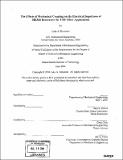The effects of mechanical coupling on the electrical impedance of MEMS resonators for UHF filter applications
Author(s)
Hohreiter, Luke A. (Luke Alfred), 1979-
DownloadFull printable version (16.21Mb)
Other Contributors
Massachusetts Institute of Technology. Dept. of Mechanical Engineering.
Advisor
Amy E. Duwel.
Terms of use
Metadata
Show full item recordAbstract
(cont.) This thesis presents finite elements based simulations of electromechanical transfer functions for resonator and filter geometries. These Finite Element Analysis (FEA) simulations are performed using the ANSYS software and demonstrate the significance of mechanical coupling between MEMS longitudinal-mode bar (L-Bar) resonators. An analytical model and equivalent circuit are derived for a single L-Bar resonator. The analytical derivation is validated with an FEA model having the same material parameters and boundary conditions. The center frequency and resonant impedance produced by the FEA model are within 1% of the analytical values. A boundary condition study is undertaken to determine the sensitivity of the L-Bar resonator model to changes in the peripheral geometry and displacement constraints. A comparison of FEA results indicates that a simple resonator model with only tether supports yields impedance and center frequency values comparable to those of more complex geometries. When compared to initial experimental results from an actual resonator, the simulated electrical output corresponds well to the actual transfer function. This study also introduces a method for calculating the parameters of the resonator's equivalent circuit model from simulated (or measured) transfer function data. The method is tested on simulation data for which a mechanical Quality factor is designated. Comparing the prescribed mechanical Q to the extracted circuit Q provides a consistency check for the technique. The parameter extraction technique is a useful first attempt to devise a comprehensive method for determining circuit parameters that will reliably reproduce the transfer function of an actual resonator. Finally, a new resonator topology (cont.) is presented that employs mechanical coupling between L-Bar resonators to improve upon the output of a single bar and create alternative configurations for filter design at Draper. The new coupled bar geometry can be configured as either a single-port resonator or a multi-port filter. The benefits of mechanical coupling are investigated for both configurations. In discussion of future work, optimized filter parameters are presented, along with suggestions for achieving these values.
Description
Thesis (S.M.)--Massachusetts Institute of Technology, Dept. of Mechanical Engineering, 2004. Includes bibliographical references (p. 137-138).
Date issued
2004Department
Massachusetts Institute of Technology. Department of Mechanical EngineeringPublisher
Massachusetts Institute of Technology
Keywords
Mechanical Engineering.